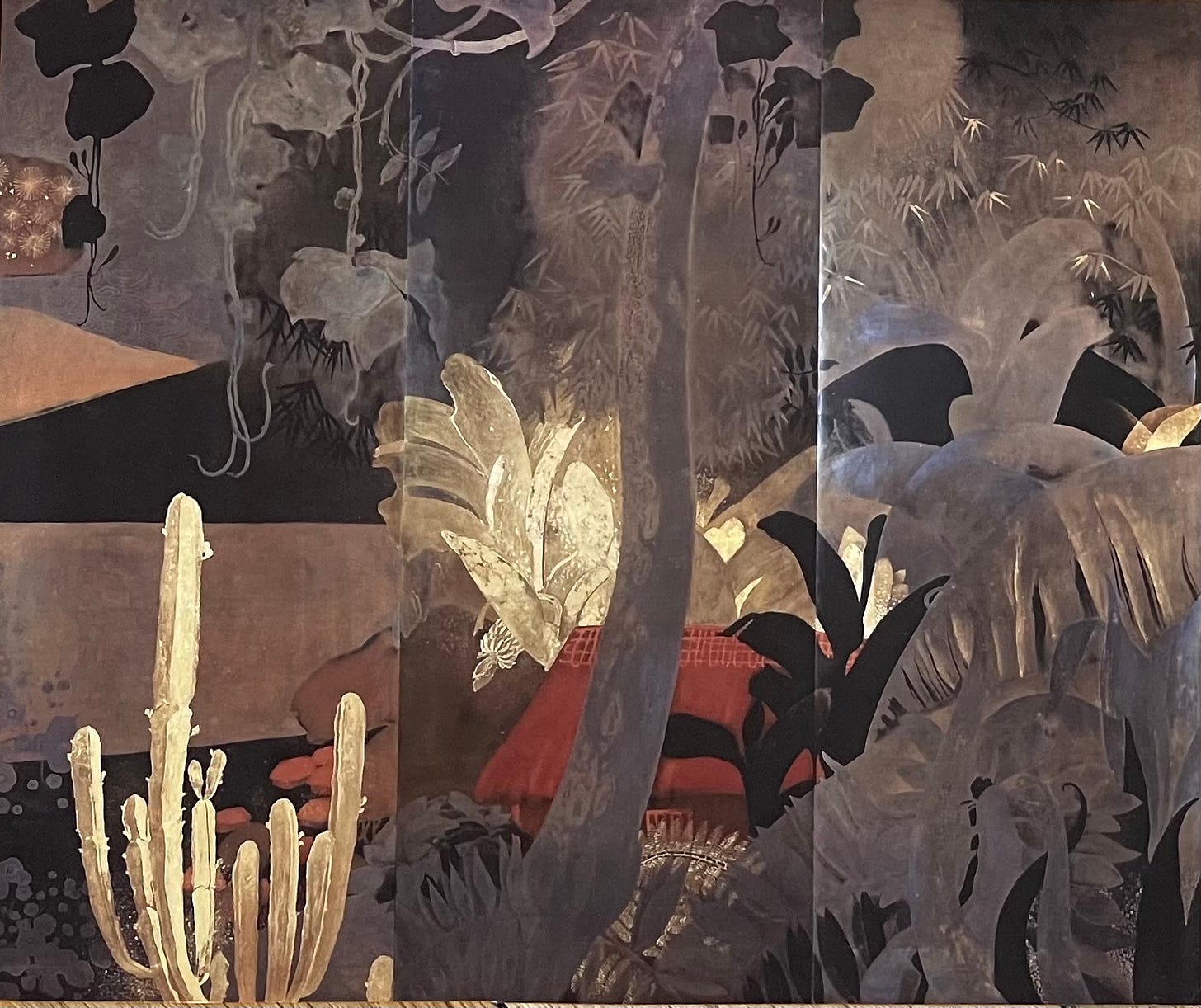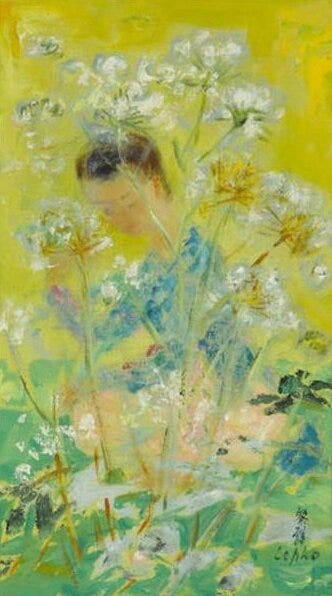
Lê Phổ (1907–2001) stands as a foundational figure in twentieth-century Vietnamese modern art, synthesizing French Impressionist and Post-Impressionist techniques with traditional Vietnamese themes, most notably elongated women in áo dài, lotus ponds, and intimate domestic scenes. Born into an elite colonial family in Hà Nội, he trained at the École Supérieure des Beaux-Arts de l’Indochine (1925–30) before earning a scholarship to Paris’s École des Beaux-Arts (1930–32) under Victor Tardieu. Over three career phases, his early Hanoi/Paris period, the Galerie Romanet period (c. 1946–62), and the Wally Findlay period (1963–2001), Lê Phổ evolved from nostalgic Tonkinese landscapes to his signature luminous oils and silken watercolors. His work has fetched record prices at Christie’s and Sotheby’s, and in 2024–25 he was honored in the Musée Cernuschi retrospective “Lê Phô, Mai-Thu, Vũ Cao Đàm: Pioneers of Modern Vietnamese Art,” confirming his enduring status as a bridge between East and West.
Lê Phổ was born on August 2, 1907 in Thanh Xuân, Hà Nội, into a mandarin family allied with the French colonial administration (Sothebys.com). From 1925 to 1930, he studied at the École Supérieure des Beaux-Arts de l’Indochine in Hanoi, mastering academic drawing, oil painting, lacquer techniques, and traditional East Asian brushwork (Wikipedia). His silk painting La famille dans le jardin (c. 1929), depicting a tranquil family scene amid lush foliage, sold for US $2.37 million at Sotheby’s Hong Kong in April 2023, showcasing his nostalgic engagement with Vietnamese themes alongside Impressionist light and color mastery (e.vnexpress.net, Sothebys.com).
In 1930 Lê Phổ received a scholarship to the École des Beaux-Arts in Paris, studying under Victor François Tardieu, co-founder of the Indochine school and a confidant of Henri Matisse (Wikipedia). During 1930–32, he refined plein-air techniques, experimented with silk painting, and immersed himself in Impressionist and Post-Impressionist color theory (Sothebys.com).
Under Tardieu’s mentorship, Lê Phổ adopted broken brushwork, impasto, and an emphasis on natural light reminiscent of Monet and Renoir (Sothebys.com). Yet his works retain structural solidity from his Hanoi training: figures are carefully proportioned, and compositions maintain balance between spontaneity and formality (Sothebys.com).

Simultaneously, he rooted his imagery in Vietnamese culture: women in flowing áo dài, lotus and bamboo, and mother-child vignettes. In works like Nativité (silk, c. 1950s), the ethereal glow of silk painting evokes both Impressionist luminosity and the contemplative stillness of traditional ink scrolls (Sothebys.com).

Early in his career, Lê Phổ mastered traditional techniques in works like Paysage Tonkinois (lacquer on panel, 1932–34), which captures the serene landscapes of rural Tonkin with tender brushwork and rich, layered tones, demonstrating both his academic precision and emerging expressiveness. In 1937, he was appointed as a delegate and juror for the Paris Exposition Internationale, marking his debut on the European exhibition circuit.

After World War II, Lê Phổ entered his Galerie Romanet period in Paris, during which he focused on semi-Impressionist interiors and lush garden scenes (Wikipedia). Femme dans un jardin (c. 1955) is a prime example. Its elongated, graceful female figure reflects the influence of Amedeo Modigliani’s stylized silhouettes (Alain R Truong Vietnam). Meanwhile, the vibrant, harmonious palette, rich in warm pinks, ochres, and verdant greens, recalls Pierre Bonnard’s decorative color sensibility (Alain.R.Truong). Lê Phổ balances these Western influences with a compositional restraint rooted in his École Supérieure des Beaux-Arts de l’Indochine training, ensuring the scene remains both intimate and spacious (Wikipedia). The arrangement of furniture, drapery, and foliage creates a rhythmic interplay of line and form, guiding the viewer’s eye through the interior-garden threshold (MutualArt). Despite its size, Femme dans un jardin conveys a serene, almost meditative atmosphere characteristic of Lê Phổ’s mature style (Alain R Truong Vietnam). The work exemplifies how, during his Romanet years, Lê Phổ fused European modernist techniques with Vietnamese thematic content to produce a hybrid aesthetic (Wikipedia). Collectors and scholars regard Femme dans un jardin as emblematic of Lê Phổ’s ability to evoke both the elegance of post-war Parisian salon painting and the timeless grace of Vietnamese tradition (Alain.R.Truong).

From 1963, under American gallerist Wally Findlay, he created larger oil canvases for U.S. collectors. Femme aux fleurs (c. 1970) exemplifies his mature style, shimmering blossoms and poised figures rendered in harmonious, luminous palettes, achieving six-figure auction results at Christie’s and Bonhams (Hanoitimes, Sothebys.com).

The 2024–25 Musée Cernuschi retrospective Lê Phô, Mai-Thu, Vũ Cao Đàm: Pioneers of Modern Vietnamese Art showcased 150 works, tracing his journey from Hanoi to Paris and underscoring his role in Indo-Chinese modernism (Musée Cernuschi). Record auction performances, e.g., Femme dans un jardin selling for US $2.37 million at Sotheby’s Hong Kong (2023) and Nue fetching HKD 10.9 million at Christie’s Hong Kong (2019), confirm his market stature and the global appetite for his hybrid aesthetic (VnExpress International, Hanoitimes).
By fusing French modernist technique with Vietnamese iconography, Lê Phổ forged a transnational artistic language that paved the way for subsequent generations of Vietnamese artists. His oils and silken watercolors remain in major museum collections and continue to inspire scholarly research, affirming his enduring legacy as a cultural ambassador and innovator (Sothebys.com, Wikipedia).
Works Cited
Bonhams. Femme dans un jardin. Asian Art, 14 Apr. 2016, lot 43, https://www.bonhams.com/auctions/22434/lot/43/.
Findlay Galleries. Lê Phô. FindlayGalleries.com, https://findlaygalleries.com/artists/le-pho. Accessed 12 Feb. 2025
Hanoi Times. Nue (Nude) by Lê Phổ Fetches HKD 10.9 Million. Hanoi Times, https://hanoitimes.vn/a-self-portrait-of-painter-le-pho-was-auctioned-for-one-million-dollars-316739.html. Accessed 12 Feb. 2025.
Musée Cernuschi. Lê Phô, Mai-Thu, Vũ Cao Đàm: Pioneers of Modern Vietnamese Art. cernuschi.paris.fr, https://www.cernuschi.paris.fr/en/exhibitions/le-pho-mai-thu-vu-cao-dam-pioneers-modern-vietnamese-art-france. Accessed 12 Feb. 2025
Rehs Galleries. Lê Phô. RehsGalleries.com, https://rehs.com/eng/bio/le-pho/. Accessed 12 Feb. 2025.
Sotheby’s. 20th Century & Contemporary Art Evening Sale. Sothebys.com, lot 1052, https://www.sothebys.com/en/auctions/ecatalogue/2016/modern-contemporary-asian-art-evening-sale-hk0654/lot.1052.html. Accessed 12 Feb. 2025.
Sotheby’s. Pioneering Modern Vietnamese Art: Lê Phô’s Journey From the Early Years to 1937. Sothebys.com, https://www.sothebys.com/en/articles/pioneering-modern-vietnamese-art-le-phos-journey-from-the-early-years-to-1937. Accessed 12 Feb. 2025.
Sotheby’s. Sotheby’s Modern & Contemporary Southeast Asian Art. Sothebys.com, lot 244, https://www.sothebys.com/en/auctions/ecatalogue/2016/modern-contemporary-southeast-asian-art-hk0632/lot.244.html. Accessed 12 Feb. 2025.
Sotheby’s. Vietnam Through the Eyes of 5 Artists. Sothebys.com, https://www.sothebys.com/en/articles/vietnam-through-the-eyes-of-5-artists. Accessed 12 Feb. 2025.
Sotheby’s. Why Vietnamese Art Is Having a Moment: Sotheby’s Experts Weigh In. Sothebys.com, https://www.sothebys.com/en/articles/why-vietnamese-art-is-having-a-moment-sothebys-experts-weigh-in. Accessed 12 Feb. 2025.
Wikipedia. Lê Phổ. Wikipedia, https://en.wikipedia.org/wiki/L%C3%AA_Ph%E1%BB%95. Accessed 12 Feb. 2025.




Thank you for turning me on to Lê Phổ, it is always astounding to find such a marvelous artist and body of work that seems like one that we all should have know like we know Renoir or Monet.
This is a beautifully written and deeply informative piece—thank you for shedding light on the nuance and evolution of Lê Phổ’s career. I was especially struck by how clearly you traced the way his work harmonizes French Impressionist techniques with Vietnamese subjects without ever losing a sense of rootedness. The comparison to Monet, Modigliani, and Bonnard helped me see his paintings with new eyes, while your descriptions of silk and lacquer techniques brought out the textural sensitivity of his work.